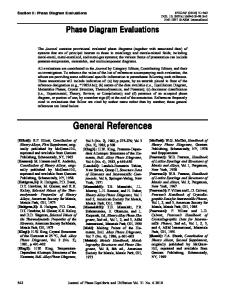The Dy-Zn phase diagram
- PDF / 1,182,476 Bytes
- 8 Pages / 612 x 792 pts (letter) Page_size
- 46 Downloads / 378 Views
UCTION The Dy-Zn investigation is part of a program carried out by our research group and devoted to the study of the alloying behavior of the trivalent rare earth metals (REs) with zinc. To this aim, the Gd-Zn system has been recently investigated.[1] Moreover, the effects of the Zn additions[2] on the melting and transformation temperatures of Pr and Gd, chosen as representatives of the behavior of the light and heavy lanthanides and the thermodynamic properties of Nd-Zn alloys,[3] have also been experimentally studied. Constitutional properties of the Dy-Zn system are lacking. A sketch of the phase diagram from 0 to 66.7 at pct Zn is given in the literature,[4] based on information summarized by Bruzzone et al.[5] A number of Dy-Zn intermetallic phases (and their structures) have been reported:[6] DyZn (cP2-CsCl type), DyZn2 (oI12-CeCu2), DyZn3 (oP16YZn3), Dy3Zn11 (oI28-Al11La3), Dy6Zn23 (cF116-Th6Mn23), Dy13Zn58 (hP142-Gd13Zn58), DyZn5 (hP6-CaCu5), Dy2Zn17 (High Temperature form, hR57-Th2Zn17, Low Temperature form hP38-Th2Ni17), and DyZn12 (tI26-ThMn12). The experimental results obtained for the Dy-Zn system will be reported in Section III. A preliminary report by our group has been recently published.[7] II. EXPERIMENTAL DETAILS The metals used were dysprosium (99.9 mass pct nominal purity) and zinc (99.99 mass pct nominal purity), both supplied by NewMet Koch (Waltham Abbey, U.K.). Alloys were prepared by weighing stoichiometric amounts of small pieces of the two metals, which were then sealed in tantalum crucibles under argon atmosphere; the crucibles A. SACCONE and S. DELFINO, Full Professors, A.M. CARDINALE, Researcher, and R. FERRO, Professor Emeritus, are with the Department of Chemistry, University of Genova, 31 I-16146 Genova, Italy. Contact e-mail: [email protected] Manuscript submitted September 5, 2002. METALLURGICAL AND MATERIALS TRANSACTIONS A
were induction heated under inert atmosphere to prevent oxidation. During the melting, the homogenization was guaranteed by shaking the crucible. No side reaction with the crucible was found. A few samples were subjected to different thermal treatments. The techniques used to characterize the samples were the following. A. Differential Thermal Analysis Differential thermal analysis (DTA) was carried out, both on heating and on cooling, at rates between 5 and 10 K min-1 by using samples enclosed in sealed tantalum crucibles. Particular attention was paid to the samples in the Zn-rich side of the system because of the high vapor pressure of zinc. The instrument used is a model 404S Netzsch apparatus (Selb, Germany). In the temperature range examined, the accuracy was estimated to be within ±0.5 pct of the measured value. The temperature values were obtained from the DTA curves using the extrapolated onset temperatures. The thermocouples used were Pt, Pt-10 pct Rh, calibrated by means of the melting points of Al, Ag, and Au. B. Metallographic Analysis Metallographic analysis was performed by using light optical and scanning electron microscopy; the samples
Data Loading...











